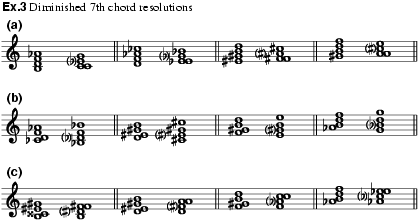A
chord formed from a diminished triad with added diminished 7th, for example
B–D–F–A![]() ; it thus
contains two tritones (B–F and D–A
; it thus
contains two tritones (B–F and D–A![]() ) and is tonally unstable. It is typically found on
the raised 7th degree of a minor key and functions, in its standard resolution
to the tonic (ex.1a), like a dominant chord, the
7th (G
) and is tonally unstable. It is typically found on
the raised 7th degree of a minor key and functions, in its standard resolution
to the tonic (ex.1a), like a dominant chord, the
7th (G![]() in ex.1a) rising by semitone to the tonic while
the other notes fall; it is commonly borrowed for equivalent use in the major
mode (ex.1b). Its root may be defined
conventionally, as the lowest note when the chord is rearranged as a sequence
of thirds (G
in ex.1a) rising by semitone to the tonic while
the other notes fall; it is commonly borrowed for equivalent use in the major
mode (ex.1b). Its root may be defined
conventionally, as the lowest note when the chord is rearranged as a sequence
of thirds (G![]() in ex.1a and b; see also Root, ex.1a); however,
because of the manner of its resolution, the chord is sometimes interpreted as
an incomplete dominant 9th with the root omitted (in ex.1a and b the ‘missing root’ would be E).
in ex.1a and b; see also Root, ex.1a); however,
because of the manner of its resolution, the chord is sometimes interpreted as
an incomplete dominant 9th with the root omitted (in ex.1a and b the ‘missing root’ would be E).

Because
the four notes in the diminished 7th chord are a minor 3rd (or augmented 2nd)
apart, the chord divides the octave into four equal segments (ex.2); as a result of this symmetry and of the phenomenon of
enharmonic equivalence, the multiplicity of possible diminished 7th chords may
be reduced to three distinct pitch collections (B–D–F–A![]() , B
, B![]() –D
–D![]() –F
–F![]() –A and C
–A and C![]() –E–G–B
–E–G–B![]() ), with all their respellings and inversions. By means
of such reinterpretation, and by permitting resolutions in which the lowest
note either falls by semitone or remains at the same pitch, any one of these
pitch collections can resolve to a major or minor triad on any pitch. Ex.3 sets out 24 possible resolutions of the collection B–D–F–A
), with all their respellings and inversions. By means
of such reinterpretation, and by permitting resolutions in which the lowest
note either falls by semitone or remains at the same pitch, any one of these
pitch collections can resolve to a major or minor triad on any pitch. Ex.3 sets out 24 possible resolutions of the collection B–D–F–A![]() : in ex.3a the lowest note rises by semitone, while
in ex.3b it falls by semitone, and in ex.3c it stays constant. The existence of so
many different possibilities for resolution gives the diminished 7th chord
ambiguous tonal implications, making it an important tool in modulation (see J.
Saslaw: ‘Gottfried Weber and Multiple Meaning’, Theoria, v (1990–91),
74–103).
: in ex.3a the lowest note rises by semitone, while
in ex.3b it falls by semitone, and in ex.3c it stays constant. The existence of so
many different possibilities for resolution gives the diminished 7th chord
ambiguous tonal implications, making it an important tool in modulation (see J.
Saslaw: ‘Gottfried Weber and Multiple Meaning’, Theoria, v (1990–91),
74–103).


JANNA SASLAW